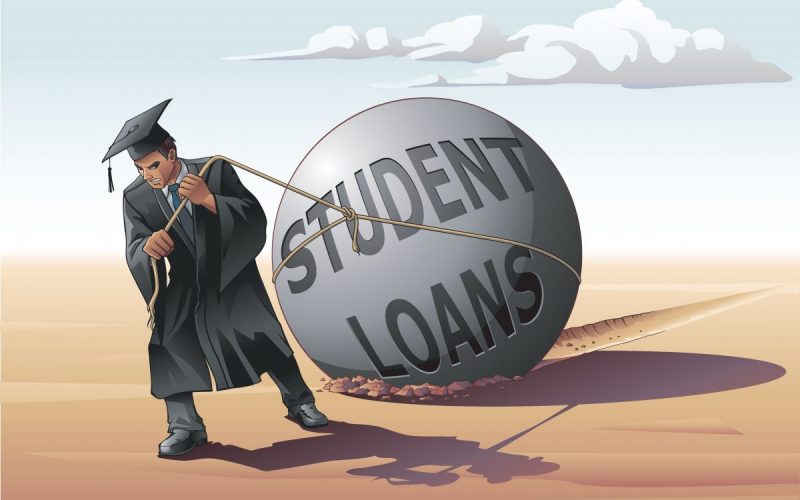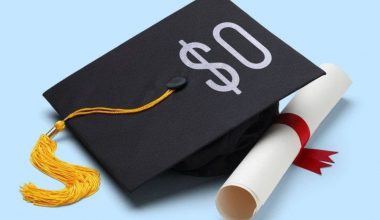Adulting 101 begins during college. It’s an exciting time filled with new experiences, independence, and maybe a little bit of stress about how to pay for it all. You’ve heard of student loans, those helpful tools that can bridge the gap between scholarships and the total cost of college. But there are different types, and sometimes it can feel like cracking a secret code!
Are there student loans that go directly? One option you might be wondering about is direct student loans. Think of it like getting money straight from the government, instead of borrowing from a bank.
In this article, we will help you understand direct student loans! We’ll break down everything you need to know, from how they work to the steps to apply.
Table of contents
- What is a Student Loan?
- What are student loans that go directly to the student?
- How can I find student loans that go directly to me? Step-by-Step Guide
- Are there any federal student loans that go directly to the student?
- What is the process for applying for student loans that go directly to the student? Step-by-Step Guide
- Can I use student loans that go directly to me for non-tuition expenses?
- Are private student loans that go directly to the student a good option?
- What are the eligibility requirements for student loans that go directly to the student?
- Do student loans that go directly to the student have lower interest rates?
- Are there any disadvantages to student loans that go directly to the student?
- Can international students access student loans that go directly to them?
- FAQs
- Conclusion
- References
- Recommendation
What is a Student Loan?
A student loan is a type of financial assistance provided to students to help cover their education costs. It is a borrowed sum for educational expenses such as tuition, books, supplies, and living expenses. Government entities like the federal government or private financial institutions typically offer student loans.
When a student takes out a loan, they are responsible for repaying the borrowed amount, usually with interest, over a specified period. The terms and conditions of student loans can vary, including interest rates, repayment schedules, and eligibility criteria. One has to first understand the loan plan they are on. In many cases, students are only required to repay their loans once they graduate or leave school.
Student loans can be an important financial tool for individuals with insufficient funds to pay for their education upfront. They help make higher education accessible to a wider range of students by providing financial support. It’s important to carefully consider the terms and obligations of student loans before borrowing, as they can have long-term implications on one’s finances.
You should also read: How to Pay Off Your Student Loans in 5 Years: A Step-by-Step Guide
What are student loans that go directly to the student?
Student loans that go directly to the student, also known as direct-to-consumer loans, are loan options where the funds are disbursed directly to the student borrower rather than sent to the educational institution. These loans give the borrower more control over how the funds cover educational expenses. Here are a few examples of student loans that go directly to the student:
Private Student Loans
Private lenders, such as banks or credit unions, offer student loans directly to the student. The government does not back these loans; they typically have varying interest rates, repayment terms, and eligibility requirements. Examples of private student loan lenders include Sallie Mae, Discover Student Loans, and Wells Fargo.
Personal Loans
Some students may choose to take out personal loans from banks or online lenders to fund their education. Personal loans are not specifically designed for educational purposes but can be used to cover educational expenses. However, it’s important to note that personal loans may have higher interest rates compared to dedicated student loans.
ISAs are an alternative financing option where investors fund students in exchange for a percentage of their future income over a specified period. With ISAs, the funds are disbursed directly to the student, and repayment is based on the student’s income after graduation and securing a job. Examples of ISA providers include companies like Lambda School, Leif, and Vemo Education.
It’s essential to thoroughly research and compare the terms, interest rates, repayment options, and eligibility criteria of these loans before deciding. Federal student loans, such as Direct Subsidized Loans, Direct Unsubsidized Loans, and PLUS Loans, may provide funds directly to the student. Still, they are typically disbursed through the educational institution.
Check out this article: Can I Get Student Loans Before School Starts? Best Expert Advice
How can I find student loans that go directly to me? Step-by-Step Guide
To find student loans that go directly to you, follow these steps:
Step 1- Research loan options
Start by researching different types of student loans, both federal and private. Look for loan programs that specifically mention disbursing funds directly to the student. Explore private lenders who offer direct-to-consumer loans as well.
Step 2- Visit official websites
Visit the official websites of government agencies, such as the U.S. Department of Education’s Federal Student Aid website (studentaid.gov), to learn about federal loan programs that may disburse funds directly to students. These websites provide comprehensive information on various loan options available.
Step 3- Contact financial aid offices
Reach out to the financial aid offices of your educational institution(s) to inquire about student loans that go directly to the student. They can guide available loan options and any specific requirements or processes to follow.
Step 4- Explore private lenders
Research private lenders that offer direct-to-consumer student loans. Visit their websites or contact customer service to understand the loan terms, eligibility criteria, interest rates, and repayment options. Compare multiple lenders to find the best fit for your needs.
Step 5- Consult with financial advisors
Consider seeking advice from financial advisors specializing in student loans or financial aid. They can provide personalized guidance based on your circumstances and help you navigate the loan selection process.
Step 6- Complete the necessary applications
Once you have identified potential loan options, complete the required applications. This may involve filling out the Free Application for Federal Student Aid (FAFSA) for federal loans or submitting separate applications for private loans. Ensure you provide accurate and up-to-date information to maximize your chances of approval.
Are there any federal student loans that go directly to the student?
No, there are no federal student loans that go directly to the student. Federal student loans, including Direct Subsidized Loans, Direct Unsubsidized Loans, and LUS Loans, are typically disbursed directly to the educational institution. The school then applies the funds to cover tuition, fees, and other educational expenses. Any remaining funds are usually provided to the student for other education-related costs.
The funds disbursed through federal student loans are intended to support the student’s education and are sent to the school to ensure they are used appropriately. This system helps ensure the funds are allocated correctly and used for their intended purpose.
While federal student loans do not go directly to the student, they provide essential financial aid options with favorable terms, such as fixed interest rates, income-driven repayment plans, and deferment options. Students need to work closely with their school’s financial aid office to understand how federal student loans are processed and disbursed at their specific institution.
Check out this article: Is There A Statute Of Limitations On Student Loans?
What is the process for applying for student loans that go directly to the student? Step-by-Step Guide
The process for applying for student loans that go directly to the student varies depending on the type of loan, whether federal or private. Here is a step-by-step guide that outlines the general process:
- Research loan options: Begin by researching different loan options available to you, both federal and private. Look for loans that explicitly state they are disbursed directly to the student.
- Understand eligibility requirements: Familiarize yourself with the eligibility criteria for the loans you are interested in. This may include factors such as enrollment status, credit history, income, and citizenship status. Federal loans have specific eligibility requirements. In contrast, private loans may have additional criteria set by the lender.
- Complete the Free Application for Federal Student Aid (FAFSA): If you are interested in federal student loans, complete the FAFSA online at studentaid.gov. The FAFSA determines your eligibility for federal financial aid programs, including loans. Make sure to provide accurate and up-to-date information. The FAFSA is typically available starting October 1st for the upcoming academic year.
- Review your Student Aid Report (SAR): After submitting the FAFSA, you will receive a Student Aid Report (SAR) via email or mail. Review the SAR for any errors or discrepancies and make necessary corrections if required.
- Accept or decline loans: Review the financial aid award letter and carefully consider the loan options presented. Determine the amount you need to borrow and assess the terms and conditions of each loan. Accept or decline the loans accordingly.
- Complete additional requirements for private loans: If you are considering personal loans, visit the websites of various lenders to explore their loan options. Each lender may have different application requirements. Complete any necessary applications, provide required documentation, and meet any additional criteria set by the lender.
Read also: What To Do When Student Loan Account Is Closed Due To Transfer
Can I use student loans that go directly to me for non-tuition expenses?
Yes, student loans that go directly to you can be used to cover both tuition-related expenses and non-tuition expenses. While the primary purpose of student loans is to assist with educational costs, such as tuition fees, textbooks, and supplies, they often provide flexibility in how the funds can be used.
Non-tuition expenses that student loans can cover include:
- Housing and rent: Student loans can be used to pay for housing expenses, including rent, utilities, and security deposits.
- Food and groceries: The funds can be used to cover the cost of meals and groceries during your studies.
- Transportation: Student loans can be used for transportation expenses, such as public transportation costs, fuel for commuting, or maintenance and repairs for a vehicle.
- Personal expenses: Student loans may be utilized for personal expenses like clothing, personal care items, and other day-to-day necessities.
- Study materials and equipment: Funds from student loans can be used to purchase books, study materials, laptops, software, and other equipment required for your education.
Remember that student loans must be repaid with interest, so consider your future financial obligations and create a budget to manage your loan funds effectively.
You should also read: Can You Get a Masters Maintenance Student Loan For a Master’s Degree?
Are private student loans that go directly to the student a good option?
Whether private student loans that go directly to the student are, a good option depends on individual circumstances and factors such as financial need, eligibility, and the terms and conditions of the loan. Here are some considerations to help evaluate if private student loans are suitable for you:
- Interest rates: Private student loans may have variable or fixed interest rates. Compare the interest rates offered by different lenders with federal loan options. Federal loans often have more favorable fixed interest rates, while private loans may have higher rates. Consider the long-term impact of interest rates on the total repayment amount.
- Repayment terms and options: Understand the repayment terms and opportunities private lenders offer. Some lenders provide flexibility, such as deferment or forbearance options, or offer repayment plans that align with your financial situation. Compare these options with federal loan programs, often providing more repayment flexibility and forgiveness programs.
- Borrowing limits: Private student loans may have higher borrowing limits than federal loans. Assess your financial needs and ensure that you borrow responsibly, taking into account your ability to repay the loan in the future.
- Availability of grants and federal aid: Before considering private student loans, exhaust all available federal financial aid options, including grants, scholarships, and federal loans. Federal loans often have more borrower protections, lower interest rates, and more flexible repayment options.
- Shop around and compare lenders: Research multiple private lenders to find the best loan terms, interest rates, and customer service. Compare the benefits, fees, and customer reviews to make an informed decision.
What are the eligibility requirements for student loans that go directly to the student?
The eligibility requirements for student loans that go directly to the student can vary depending on the type of loan, whether federal or private. Here is a general guide to help you understand the eligibility criteria for student loans:
Federal Student Loans:
- Citizenship or legal residency: Generally, you must be a U.S. citizen, a U.S. national, or an eligible non-citizen to qualify for federal student loans. Some non-citizens, such as eligible permanent residents and refugees, may also be suitable.
- Enrollment in an eligible educational institution: To receive federal student loans, you must be enrolled or accepted at an eligible college, university, or vocational school.
- Academic progress: For most federal loans, you must maintain satisfactory academic progress, as defined by your educational institution, to remain eligible for future disbursements.
- Financial need (for certain federal loans): Need-based loans like Direct Subsidized Loans require demonstrating financial need, which is determined by completing the Free Application for Federal Student Aid (FAFSA). The FAFSA assesses your family’s financial situation, including income, assets, and household size.
- Compliance with Selective Service registration: Male applicants must be registered with the Selective Service System, which is required for most males aged 18 to 25.
- No default on previous federal loans: You must not be in default on any federal student loans or owe an overpayment on federal grants.
Private Student Loans:
- Creditworthiness: Private lenders typically evaluate your credit history and credit score to determine eligibility. Strong credit or a creditworthy cosigner can increase your chances of approval.
- Enrollment in an eligible institution: Private lenders generally require you to be enrolled or accepted as a student at an eligible college, university, or vocational school.
- Income: Some private lenders may consider your income or the income of a cosigner to determine eligibility and loan terms.
- Age and legal capacity: Most private lenders require borrowers to be at least 18 years old and have the legal ability to enter into a contract.
Always check with the lender or financial aid office for the most accurate and up-to-date information on eligibility criteria for student loans.
You should also read: How To Get Student Loans For Mature Students: 6 Things To Know
Do student loans that go directly to the student have lower interest rates?
Student loans that go directly to the student do not necessarily have lower interest rates than other student loans. The interest rates on student loans can vary based on several factors, including the type of loan, whether it is a federal or private loan, the borrower’s credit history, and the current market conditions.
Federal Student Loans
Federal student loans, typically disbursed to the educational institution, have fixed interest rates set by the government. These rates are determined annually and may vary depending on the type of loan.
For example, Direct Subsidized Loans and Direct Unsubsidized Loans for undergraduate students have different interest rates than PLUS Loans for graduate students and parents. Federal student loan interest rates are generally set at a lower rate compared to private student loans.
Private Student Loans
Banks, credit unions, and other private lenders offer private student loans, including those that go directly to the student. The interest rates for personal loans are determined by the lender and are influenced by factors such as the borrower’s creditworthiness and the overall market conditions.
Private student, loan interest rates can range from relatively low to higher rates, depending on individual circumstances and the specific terms of the loan.
When considering student loans, comparing various lenders’ interest rates and loan terms is essential. Federal student loans often offer more favorable interest rates and borrower protections, such as income-driven repayment plans and forgiveness options.
However, that option may be worth considering if you have excellent credit and can secure a competitive interest rate from a private lender.
You should also read: What Happens to Your Student Loans When You Die?
Are there any disadvantages to student loans that go directly to the student?
While student loans that go directly to the student can provide financial assistance, they have potential disadvantages that borrowers should consider. Here are some common drawbacks associated with such loans:
- Higher interest rates: Student loans that go directly to the student, particularly private loans, may have higher interest rates than federal student loans. Higher interest rates can increase the overall cost of borrowing and result in higher monthly payments.
- Creditworthiness requirements: Private student loans often require a good credit history or a creditworthy cosigner. If you have limited credit or poor credit history, qualifying for a private loan without a cosigner or securing favorable interest rates may be challenging.
- Limited borrower protections: Private student loans typically offer fewer protections than federal loans. In certain circumstances, federal loans provide options such as income-driven repayment plans, loan forgiveness programs, and loan discharge. Private loans may offer a different level of flexibility in repayment terms or hardship assistance.
- Repayment terms: Private student loans may have less flexible repayment options than federal loans. They may not offer income-driven repayment plans or loan forgiveness options. Private lenders may also have less lenient forbearance or deferment policies, making pausing or adjusting your payments during financial hardship harder.
- Variable interest rates: Some private student loans may have variable interest rates, fluctuating over time. This can make it challenging to predict and budget for future loan payments, as the monthly payment amount may change as interest rates fluctuate.
- Lack of federal benefits: By choosing private student loans that go directly to the student, you may miss out on various benefits offered by federal student loans. These benefits can include loan forgiveness programs for certain professions, public service loan forgiveness, and loan rehabilitation or consolidation opportunities.
Also, read: What Happens if You Don’t Pay Your Student Loans Back?
Can international students access student loans that go directly to them?
Generally, international students face challenges in accessing student loans that go directly to them, especially when it comes to federal student loans. Most federal student loan programs, such as Direct Subsidized Loans and Direct Unsubsidized Loans, are available only to U.S. citizens, eligible non-citizens, and specific eligible non-citizen categories.
However, international students may have options for private student loans. Some private lenders offer student loans specifically designed for international students studying in the United States. These loans may require a U.S. cosigner with a good credit history and income. The cosigner is a guarantor for the loan and assumes responsibility for repayment if the borrower defaults.
Additionally, international students should explore other funding sources, such as scholarships, grants, or assistance programs offered by their home countries, educational institutions, or international organizations.
To understand the specific loan options available to international students, it’s advisable to consult with the financial aid office at your educational institution or reach out to lenders specializing in student loans for international students. They can guide the eligibility criteria and loan application process tailored to your unique circumstances.
Read also: What Is the Danger of Taking a Variable Rate Loan as a College Student?
FAQs
Yes, specific student loan options disburse funds directly to the student. These loans can provide financial assistance for educational expenses such as tuition, books, and living expenses.
The primary types of student loans that go directly to the student include federal loans such as Direct Subsidized Loans, Direct Unsubsidized Loans, and PLUS Loans. Private lenders may also offer student loans directly to the student, but terms and conditions can vary.
To apply for student loans that go directly to you, start by completing the Free Application for Federal Student Aid (FAFSA). This application will determine your eligibility for federal aid programs. Additionally, you may need to submit separate applications or meet specific requirements for private loans offered by individual lenders.
Student loans that go directly to the student offer certain advantages. They provide more control over how the funds are allocated, allowing you to cover various educational expenses. Additionally, these loans can provide flexibility in managing your financial obligations and offer competitive interest rates.
While student loans that go directly to the student can be beneficial, it’s essential to consider potential downsides. These loans often require the borrower to assume full responsibility for managing the funds and making timely payments.
Conclusion
Student loans that go directly to you can be a valuable financial tool for students pursuing higher education. While most student loans are disbursed to the educational institution, some loan options provide funds directly to the student. It’s essential to explore all available options and understand the requirements and terms associated with each loan.
To get student loans that go directly to you, research federal loan programs such as Direct Subsidized Loans, Direct Unsubsidized Loans, and PLUS Loans. These loans offer various benefits, including flexible repayment options and potentially lower interest rates.
References
- collegeraptor.com– Are stu-dent-loa-ns sent directly to students or school
- lendedu.com– Stu-den-t-loa-ns that pay direct
- financialaidfinder.com– Types of direct school loan channel
- nerdwallet.com– How to get a stu-dent-lo-an



